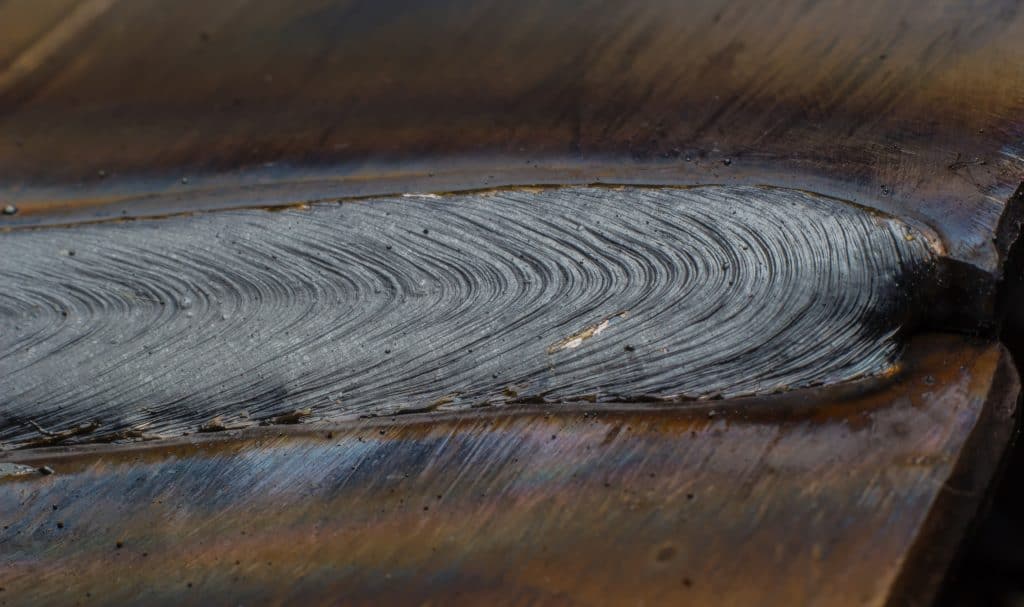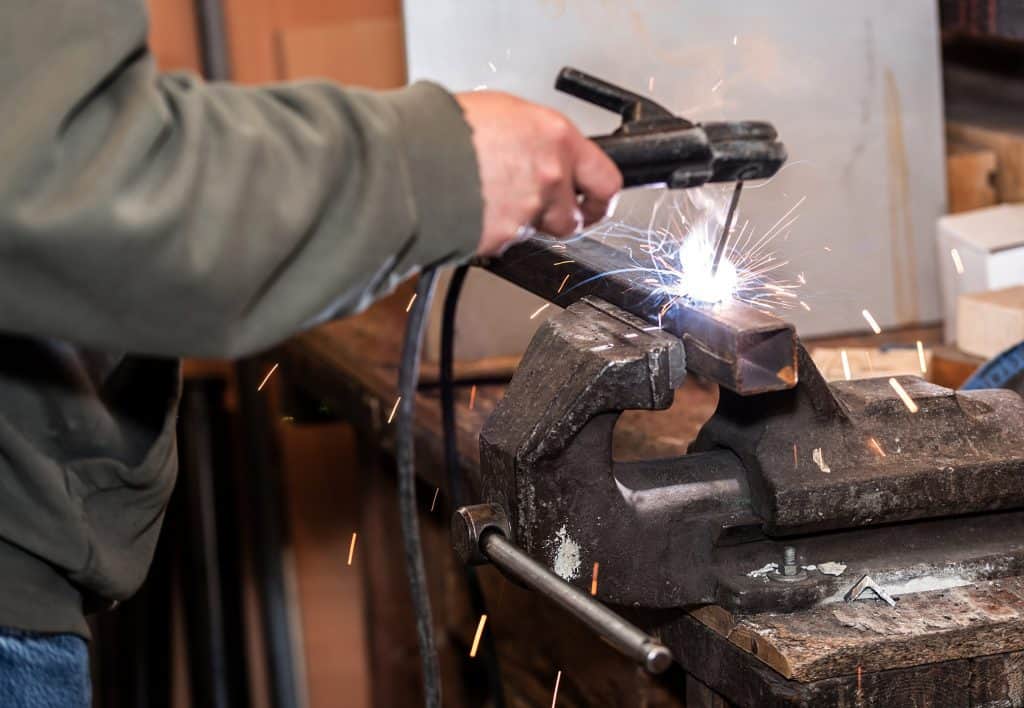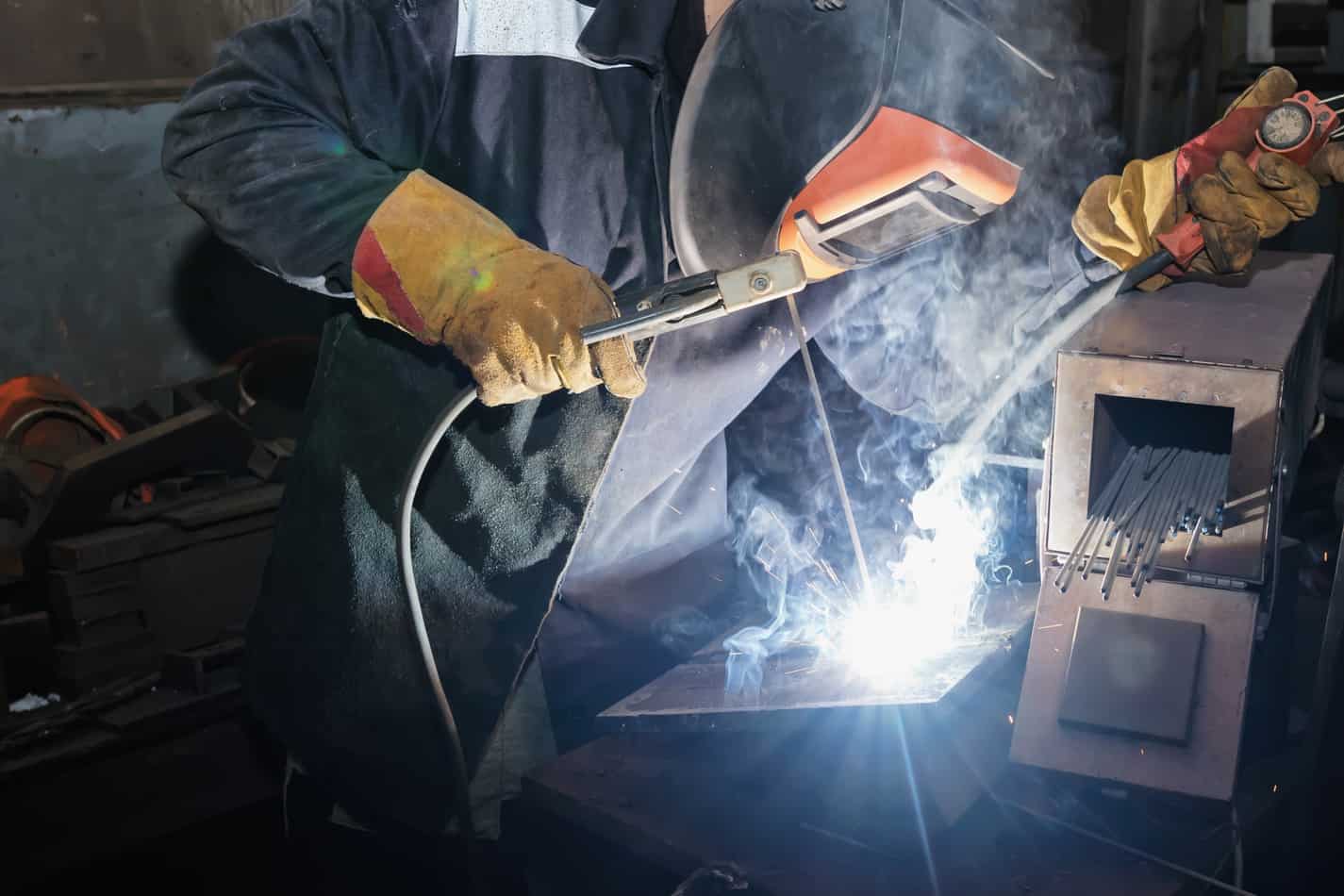“This post contains affiliate links, and I will be compensated if you make a purchase after clicking on my links.”
It’s one of the most common problems encountered while welding: You’re moving along, laying down a nice, straight bead, everything’s going smoothly, and then you notice your work doesn’t lay flat on the workbench anymore. It’s warped. It happens to the best of us. There are ways to fix that, but the best technique is one that doesn’t need fixing in the first place.
So here are 11 ways to prevent sheet metal from warping in TIG welding.
- Make light passes
- Use intermittent welding
- Use backstep welding
- Limit the number of passes
- Weld along the neutral axis
- Anticipate shrinkage
- Move around on your project
- Use clamps to control expansion
- Fix problems before they permanently set
- Work quickly
- Use anti-warping devices and techniques
Even seasoned pros, who perhaps haven’t had a serious issue with a warped piece of sheet metal in a long time, can gain new insight from some of these tips.

An Ounce of Prevention
The Battle Between Hot & Cold
The warping of metal during the welding process is due to the high levels of heat involved. At over 9000℉, the molecules in the work metal are moving as if turbo-charged, flexing, and twisting the material they constitute into forms that differ from the original shape.
And as that high threshold of heat is hard to maintain and hard to apply evenly across the work area, the molecules quickly slow down with cooling and leave the metal in a new, distorted shape.
This is called weld distortion, shrinkage, or warpage for short. This is a common issue with novice welders, and even seasoned pros are not immune to it.
Sheet metal blues
It is particularly critical in sheet metal applications, because sheet metal is thinner and lighter than many structural metals, and is far more susceptible to warpage. The trade-off is that sheet metal is easier to work with when it comes to sanding, grinding, and buffing, so when it’s time to fit the parts, the prep work is a little less intense.
If it looks bad, it probably is bad
There are many reasons why you should avoid warpage. Obviously, if the metal pieces don’t lie flat anymore, then fit, and function is affected. But more importantly, the integrity of the weld itself is compromised. Weld failure due to the warpage of the base metal can have disastrous consequences.
It’s not so much the heating process that causes the warping, but the cooling down afterward. The metal’s shape has been altered (often very slightly) by the heat, yet it wants to return to its original shape as it cools.
If the metal were evenly heated in a free and unrestrained state (not held in a vice or clamps), it would almost always return to original shape upon cool-down. But if the metal was restrained, say in a vice, the expansion of the metal during the application of heat is limited to the sides not touched by the vice jaws.
Therefore, it grows slightly thicker in those dimensions. When the metal cools, it wants to return to its original shape, but can’t, even if it’s removed from the vice.
The weld can warp too
The same rules apply – indirectly – to the weld itself. The weld material expands when hot, and wants to contract to the space it would occupy at room temperature. Still, if the adjacent base metal is warped, the weld cannot contract normally, leaving uneven, thin coverage across the joint. This is typically called shrinkage.
While there are no guarantees and no assurance that all welders will have equal success with the following practices, they’re highly recommended to prevent warping, and as they say, an ounce of prevention is worth a pound of cure.
11 ways to prevent warpage
1. Easy Does It
TIG welding is preferred where practical because it is neater and cleaner than MIG welding, which introduces new material into the weld joint. The more metal inserted into a joint, the more susceptible it is to distortion. TIG welding is an excellent example of the “less is more” premise, producing strength without adding mass (and mess).
Therefore, it makes sense to make the lightest possible pass that will still get the job done. Not only do you get a weld that is less likely to produce warpage, but you will also save on weld metal and time.
Novice welders often overestimate the size of weld needed to produce the required strength and end up using an electrode that is too big, and they hover too long in one area to achieve the melting of the metal.
2. Intermittent Welding
With a thought toward those as mentioned earlier, “less is more” concept, decide if the project really needs a solid, long bead. In a surprising number of situations, it doesn’t. When you can, use intermittent welding, which consists of leaving evenly-spaced gaps between welds instead of running a bead along the entire length of the juncture.
This leaves untouched – and therefore undistorted – sections of metal along the joint and gives the sections that were affected by the heat room for slight expansion.
3. Backstep Welding
This is similar to intermittent welding, in that the initial welds are spaced apart, but in the final process, a linear bead is applied. This technique is used when superior strength is needed, and intermittent welding would likely not produce a trustworthy weld.
The process begins with evenly-spaced welds – called button tacks – applied with the barest minimum temperature. Then, in secondary passes, a bead is applied “backward” toward the most recent weld tack. Do this section by section until you have a complete bead.
This helps prevent warpage in that you’re not running a long bead and constantly pushing an ever-increasing region of extreme heat across the metal. The affected sections expand slightly into the unaffected sections, and the cool-down is reasonably consistent throughout the whole of the base metal.
Weld tacks are often not needed at all. Sections can be marked with a pen or soapstone, but be careful you can see your marks while welding. You should already know that welding produces massive amounts of light, glare, and smoke, and if you can’t see your marks, you can easily weld right over them.
4. You Shall Not Pass (Too Often)
In many cases, it’s better to use a large electrode and make fewer passes than use a smaller electrode and make multiple passes. The effects of the heating, cooling, and resultant distortion are cumulative, with each pass running a greater risk of significant warpage. Metal takes much longer to return to room temperature than most people realize.
5. The Neutral Axis is Your Friend
There is a sweet spot on any piece of metal at which stress and strain are minimal. This is known as the neutral axis. When possible, place welds along or near the neutral axis.
Finding the neutral axis can be a painstaking process involving a lot of measuring and mathematics equations. Still, for a rule of thumb, if the metal is homogeneous (made up of one material), the neutral axis would run through the geometric center of the base metal.
Also, balancing the welds along the neutral axis is effective in preventing distortion, because they are applied evenly in the section of the metal that is the least likely to be affected by the stress of intense heating.
6. Shrinkage Happens. Learn to Anticipate it
In any construction or industrial process, the lack of planning or failure to visualize the process and anticipate problems is often a recipe for disaster. This is doubly true for welding.
Rather than jumping in on the first task, take a few minutes – or longer – to consider the entire project, or at least that day’s part of it. Look at what needs to be welded and how, and decide beforehand what technique is the best one to be employed.
Preset Your Parts
A common and effective practice for minimizing distortion is presetting the parts. Put the pieces to be bonded together in the expected configuration and run a few test welds to see where problem areas, like gaps, places where the metals push against each other, abrasions, dents, rust, etc. exist.
This is also an excellent time to lay out some tack welds for no other purpose than to hold the project together before applying the final welds. Sometimes the final welds might not happen for hours, or even days, but that’s OK. The longer until you come back to do more welding, the longer the metal has to cool back down to room temperature.
Use Shrinkage to Your Advantage
Some shrinkage is unavoidable, but the wise welder can actually use this to his or her advantage. Presetting the parts can make a tremendous difference in how well the process goes.
Essentially, to preset a couple of parts (this is also called setup in some circles), you put them together at the point of anticipated union and check for fit, for gaps and for places where the two pieces don’t square up to each other. Minor surface imperfections can be filed or sanded down on one or both pieces to be joined. Then, recheck the fit! Don’t skip this step!
Pieces that are supposed to meet at a 90-degree angle may fit perfectly at room temperature, but the shrinkage process that occurs during the welding operation may throw that off a bit.
Here, you can use let the shrinkage work for you rather than against you. Bend one of the parts back so that the angle, when it is pressed against the other piece of metal, is a tiny bit shy of 90 degrees. Then, during welding, the distortion actually pulls the pieces into a perfect right angle, if your bending was accurate.
Practice, Practice, Practice
It’s hard for a novice to get the sanding, filing, and bending procedure down just right, but it is a practice that should become a part of every welder’s routine.
Make Allowance for Restraining Devices
Another thing to anticipate is how vises and clamps and restraining devices will affect the work area. As already mentioned, when metal is restrained, expansion – and subsequently, contraction – is forced into a limited number of directions. Allowing for this helps you preset the parts more accurately.
7. Jump Around
Not literally, of course. Experts will encourage you to plan your sequence of welds prior to ever starting on the first one, but that doesn’t mean they have to be in one-two-three order. In fact, to minimize distortion, a welder should move about, so that he or she is not always working on adjacent welds.
It’s essential to limit the number of adjacent welds that you do so that the cumulative effects of the heating and cooling are not allowed to get much of a start.
This also diminishes the monotony of standing in the same place, working on the same piece with one weld after another. Tedium can lead to a lack of focus, and a lack of focus can lead to mistakes.
8. Clamps and Other Restraints

You can’t always preset workpieces with a few tack welds. For one reason or another, it becomes necessary to employ vises, jigs, and clamps to hold the parts together at the proper angle so that you can apply welds to them. This helps control distortion – rather than contribute to it – if the restraints are placed in the right places on the appropriately sized workspace.
For example, a restraint that might force expansion into one dimension and not in another can help hold down the distortion in all directions if the work area is small. This is often preferable to allowing a joint to expand or contract with no restraint at all.
There are numerous clamps available, from simple crank-down clamps similar to what a carpenter would use to tiny adjustable mighty-mites capable of holding heavy steel bars together.
9. Fix Problems Before it’s too Late
In some situations, shrinkage need not be permanent. To use one of these methods to mitigate the distortion in the work metals, the welder has to act right after setting down his or her welding torch. Generally, once a piece has cooled all the way down to room temperature, any shrinkage in the weld or any warping of the metal is likely to be permanent.
Peening
Peening is a method of counteracting the shrinkage that occurs during welding. If for years you’d wondered what a ball-peen hammer was for, this is it.
In the peening process, the welder takes the round end of a ball-peen hammer, and while the bead is cooling, lightly taps it to create dents in the material that allow some stress relief in the weld. The effect is minor in one sense, but significant if the weld is particularly critical.
A word of caution – do not overdo the peening process. Too many, or too forceful, hammer blows can compromise the strength of the weld, and if peening is used late in the cool-down period, it can make the weld material brittle.
Peening should be done between passes, and old-schoolers never peen after a final pass, so that imperfections in the weld are not covered up.
Thermal Stress Relieving
Another method for removing shrinkage is by thermal stress relieving. Here, the weld remains exposed to heat after the welding has been completed, and then the heat source is removed to allow a more controlled cool-down period. This is particularly helpful with long beads, where time has elapsed between the starting and finishing points.
10. Weld Quickly (But Properly)
The longer it takes for you to apply a weld, the more heat you are applying to the metal. Make your welds as quickly as possible while still employing the proper technique. However, do not let the desire to get done as quickly as possible dictate the size of the electrode you use or the amperage you select. That should always be appropriate for the type of weld being applied and the materials involved.
Check your work before attempting additional passes. If there is distortion, try to correct it then, because going back over the same area, or a nearby area will only exacerbate existing distortion.
11. Sheet Metal Tips
As mentioned in the introduction, sheet metal work is a different animal than steel beams. Any of the above practices can be useful in mitigating distortion in sheet metal, but there are additional practices that can come into play and perhaps save the day. These include:
Water-Cooled Jig
This helps carry heat away from the work area. The device is rigged with copper tubes through which water is circulated. An additional benefit is that the jig, when clamped to the work area, actually helps control distortion at the very source.
“Strongback”
Butt-welding large sections of sheet metal can be facilitated with this rig, which uses clamps and wedges to force alignment of the two pieces to be joined.
Heat Up, Cool Down, Repeat
With this technique, tack welds are applied along the seam with plenty of space in between. For the first go-round, all that you want is to hold the pieces in place. After the initial run of tack welds, use compressed air to cool the surface down until it is touchable with your hand. Then go back and apply more tack welds between the original ones, and cool the workspace down again. Use as many repeats as necessary, and take your time.
Run a Test
If you have the luxury of a scrap piece or two of sheet metal that is the same gauge as your working metal, do some test welds to make sure the electrode size and amperage work well with the metal.




